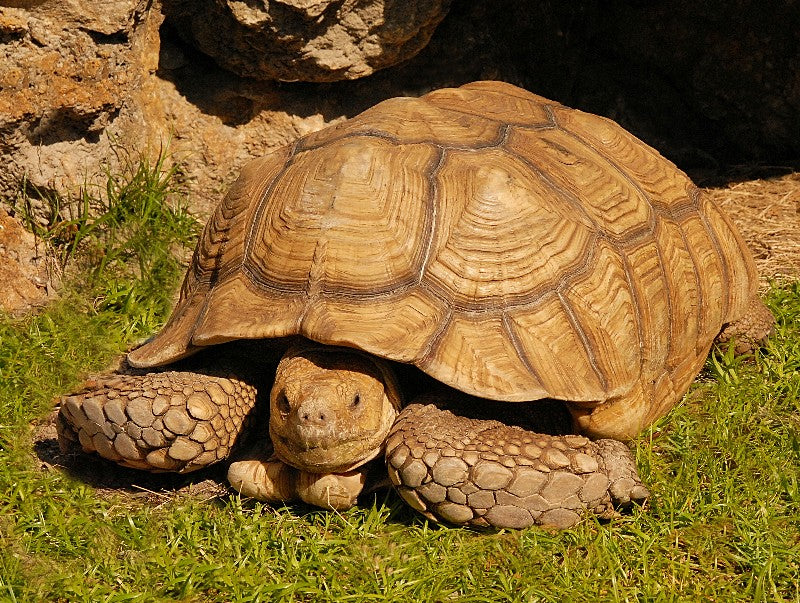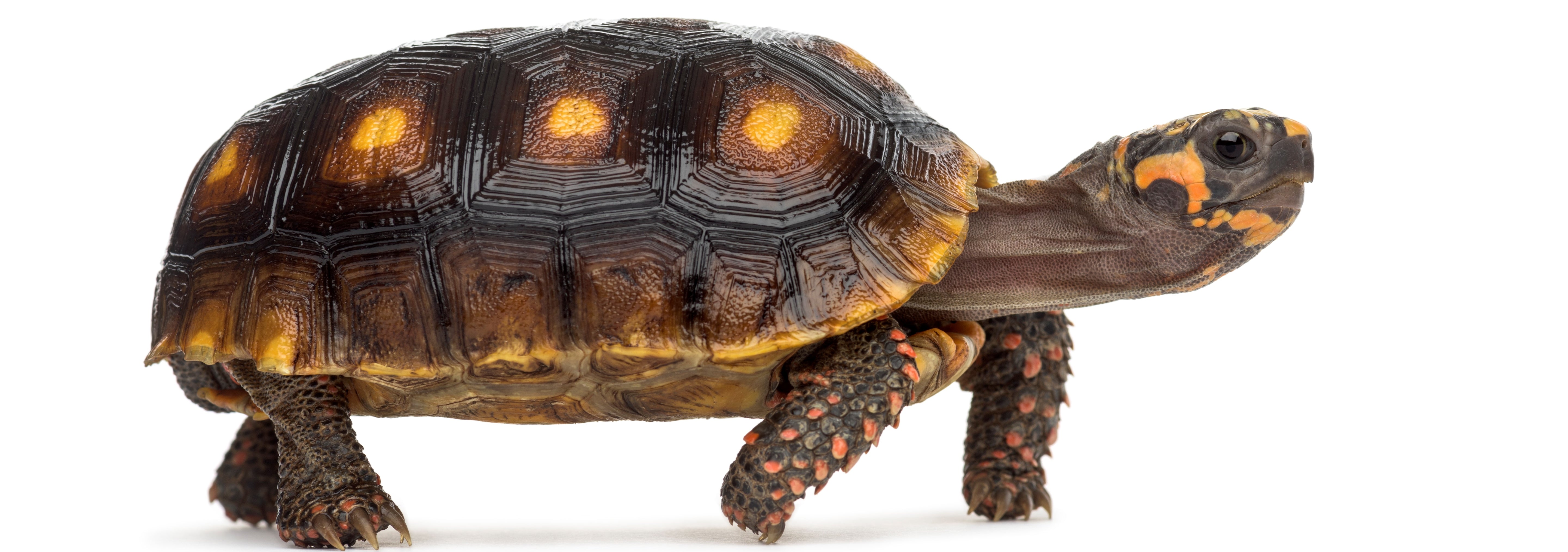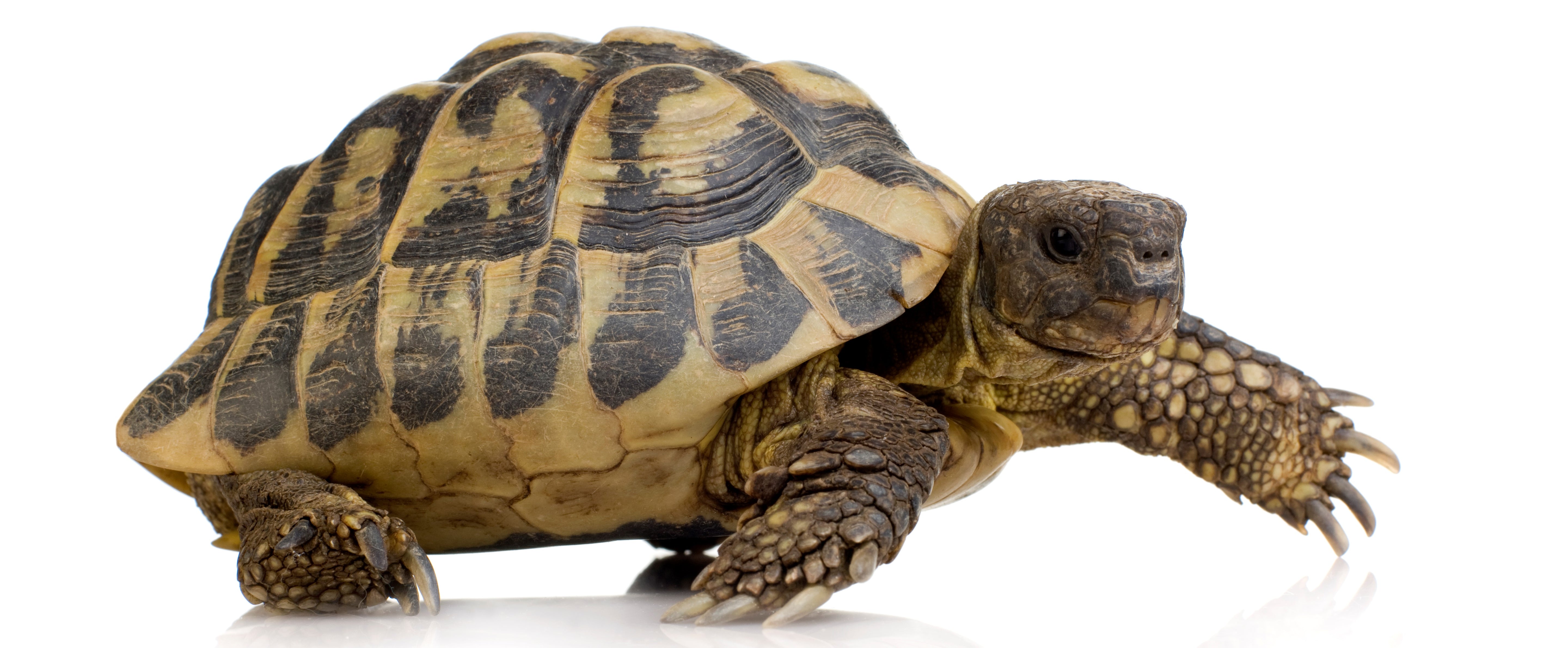Sulcata tortoises (Centrochelys sulcata) are a large tortoise species native to the hot, arid parts of Africa just south of the Sahara. They can be found in semiarid grasslands, savannas, and thorn shrublands.
Sulcata tortoises are generally tan to light brown in color, with scutes that are darker toward the edges. Their shell is gently domed. They have large, thorn-like scales on their forelegs and horn-like scales on their hind legs near the tail. They are among the largest tortoises on Earth, growing up to 24-30” long and generally up to 100 lbs. However, they are capable of growing larger — the largest sulcata on record was 41.6” long and 232 lbs!
Sulcata tortoises are commonly bred in captivity in the US, but due to their enormous size, they do not make good pets for those who can’t keep them outdoors in large pens. For those who can, they tend to have gentle, curious dispositions and are fairly easy to care for. With good care, a sulcata tortoise can live up to 70 years, possibly more.
How much space do sulcata tortoises need?
Young, small Sulcata tortoises can be kept indoors in a 4’L x 2’W or larger enclosure/tortoise table for the first few years of their life. However, sulcatas under 10 years old grow rapidly, so you will need to prepare an outdoor pen during this time. The permanent enclosure must be 50’L x 50’W x 2’H minimum, with walls that extend at least 2’ below the ground to discourage escape via digging. If you can provide larger, all the better!
Do not house more than one sulcata tortoise per enclosure.
Do sulcata tortoises need UVB?
Yes. Aside from helping provide a day/night cycle and an infinite supply of vitamin D, UVB is also essential to your tortoise’s overall health. If you are housing your sulcata outdoors, then this is not something you need to worry about, because they will get all the UVB they need from sunlight.
If you are housing your tortoise indoors, however, you will need to provide artificial UVB. The best UVB bulbs for sulcata tortoises are:
When the bulb is mounted in a Zoo Med Reptisun T5 HO Terrarium Hood fixture without mesh obstruction, it should be placed 6-8” above the top of the tortoise’s shell in the basking area. Bulbs mounted in the Arcadia ProT5 fixture can be placed further away: 17-18” above the tortoise’s shell.
The UVB bulb and fixture should be roughly half the total length of the enclosure. All lighting should be on for 13 hours/day during summer and 11 hours/day during winter.
Because a large enclosure is required for sulcata tortoises, if you are housing yours indoors, a single UVB bulb will not be enough to sufficiently illuminate the enclosure. Add a strong 6500K LED or T5 HO fluorescent grow light to energize your tortoise and better simulate daylight.
What basking temperatures do sulcata tortoises need?
If you are housing your sulcata outdoors, they do best with a local climate of 80-105°F during the year. Make sure part of the pen is shaded. Night temps as low as 60°F are tolerated well, but it’s good to provide a heated tortoise “house” maintained at 60-70°F for them to use at night.
If you are housing your sulcata indoors, they will need a basking temperature of 95-105°F, with a cool/shaded area on the other side of the enclosure between 75-80°F. Temperatures can get down to 68°F at night. Temperature should be measured with digital probe thermometers.
Use at least one halogen heat lamp placed on one side of the enclosure to create a basking area, mounted at least 8” above your tortoise’s shell to provide even heating. Do not use ceramic heat emitters (CHEs), heat mats, red bulbs, or blue bulbs, as these are not as effective.
What humidity levels do sulcata tortoises need?
As an arid species, sulcata tortoises can survive fairly low humidity levels, but they also need access to areas of higher humidity to stay hydrated. If you are housing yours outdoors, you can do this by making sure the tortoise has access to shade and a mud hole.
If you are housing your sulcata indoors, you will need a humidity gradient of about 40-75%. One of the best ways to do this is by offering a humid hide for the tortoise to use as needed. Humidity should be measured by a digital probe hygrometer with the probe in the middle of the terrarium.
Make sure your sulcata tortoise’s enclosure is not wet, as this can cause skin, shell, and respiratory problems!
What substrate is good for sulcata tortoises?
It’s ideal to use a substrate that imitates what sulcatas naturally live on in the wild. In other words, you’ll need something that resembles sandy soil. It should have small particles, not be too dusty, and pack well enough for burrowing.
If you are housing your sulcata outdoors, then unless you have moist clay soil, what you already have in your yard/pasture is likely fine. If you need to replace the soil in your tortoise’s pen, you will need to dig it out about 2’ deep, cover with flat stones, follow with a shallow layer of gravel, and then fill the rest with sandy soil from your local landscaper.
If you are housing your sulcata indoors, we recommend the following substrates for sulcata tortoises:
Plain topsoil mixed 60/40 with play sand also works well. These substrates should be at least 6” deep and completely replaced every 6 months. Remove poop and urine daily, along with contaminated substrate.
Alternatively, you can use a thick layer of clean timothy, Bermuda, orchard grass, or similar hay for substrate. This will need to be completely replaced daily.
What décor can you use in a sulcata tortoise enclosure?
It’s terribly boring for a reptile to be stuck in an enclosure with nothing in it except substrate, a hide, and food/water bowls. It doesn’t matter how big the enclosure is if you don’t put things in it for your pet to use and interact with.
Here are some décor ideas that are appropriate for sulcata tortoises:
- additional hiding places/burrows
- logs
- live, edible plants
- large, flat stones
You can also shape the substrate into hills to provide an extra challenge. Make sure, however, that your tortoise can’t flip itself over!
For outdoor enclosures, it’s best to plant a variety of drought-tolerant, grazer-resistant edible weeds and grasses. The Tortoise Table is a helpful resource for figuring out which ones are safe to plant.
What do sulcata tortoises eat?
Sulcata tortoises are herbivorous, which means that they require a high-fiber diet. They do best on a diet of mostly grasses and weeds (90%), with a small amount of “grocery store” greens and other vegetables (10%).
Safe grasses/leaves for sulcata tortoises: lawn grass, mulberry leaves, grape leaves, hibiscus leaves, meadow hay, oat hay, orchard hay, timothy, clover, dandelions, nasturtium, geranium
Safe greens and vegetables for sulcata tortoises: cactus pads, kale, collard greens, turnip greens, romaine lettuce, spring mix
Edible flowers like nasturtium, dandelions, geranium, roses, and hibiscus are great to add for variety and extra vitamins.
Food should be offered daily, and lots of it, as these tortoises are voracious eaters! Food should be offered on a plate or tray to prevent substrate ingestion. If your tortoise is starting to look chubby, reduce the amount of food that you offer per day. Note that young sulcatas do not have very strong jaws, and will struggle with dried grasses.
Fruits should be only used as a rare treat, due to their high sugar content. Appropriate fruits include apples, berries, melons, papaya, guava, pineapple, bananas, cactus fruit, apricots, pears, grapes, plums, and peaches. Pits should be removed.
Supplements
You will also need calcium and vitamin supplements to prevent your tortoise from developing a potential deficiency. We recommend Repashy Superveggie, lightly dusted on each meal. A little bit of Mazuri grassland tortoise formula or Zoo Med Natural Grassland Tortoise Food is also a good way to make sure your tortoise is getting enough vitamins.
Your tortoise should always have access to a cuttlebone for calcium.
Water
Of course, don’t forget a water bowl for your tortoise to drink from! To keep your sulcata tortoise hydrated, offer a very shallow “puddle” of water for them to drink from, not deep or large enough for soaking. For soaking, adults should be soaked in shallow, barely-warm water 1-2x/week for 15-30 minutes. Juveniles should be soaked 3x/week. The water should be no deeper than your tortoise’s elbows.
Change the drinking water daily and scrub the bowl with a reptile-safe disinfectant weekly, or whenever it becomes soiled.
Do sulcata tortoises like to be petted?
Sulcata tortoises should not be handled when it’s not necessary. However, they do respond well to hand-feeding and gentle head rubs or shell rubs.
*This care sheet contains only very basic information. Although it’s a good introduction, please do further research with high-quality sources to obtain additional information on caring for this species.
(photo credit Turtle Source)




Leave a comment
This site is protected by hCaptcha and the hCaptcha Privacy Policy and Terms of Service apply.